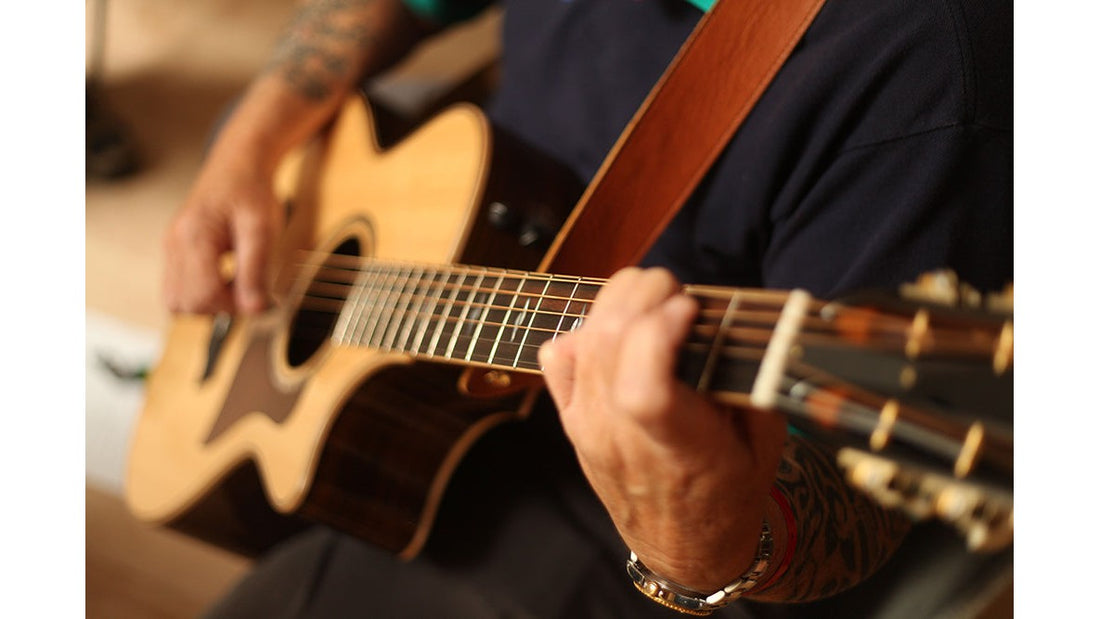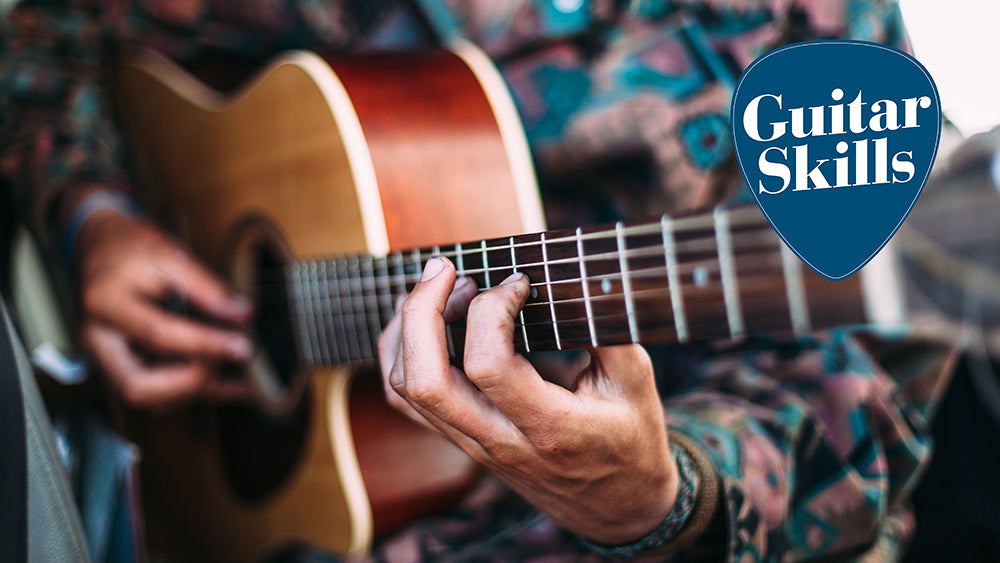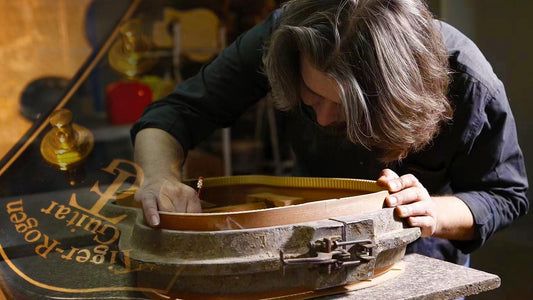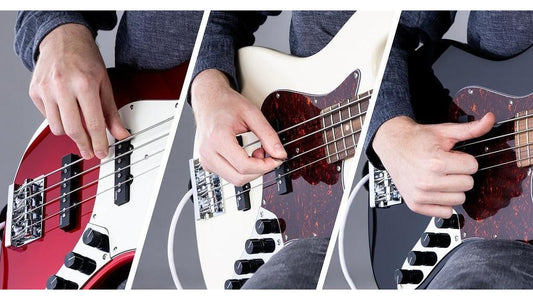
10 Cách Để Bạn Luyện Tập Chơi Đàn Guitar Acoustic
Dưới đây là 10 cách hàng đầu để thực hành kỹ thuật guitar acoustic và phát triển thói quen âm nhạc, giúp bạn cải thiện khả năng chơi đàn một cách hiệu quả nhất. Guitar acoustic là một trong những nhạc cụ dễ tiếp cận nhất và phổ biến nhất trong âm nhạc hiện đại, là lựa chọn tuyệt vời cho người mới bắt đầu. Mặc dù học guitar acoustic có thể khó hơn ghi-ta điện, tuy nhiên nó sẽ giúp bạn tăng cường sức mạnh cho các ngón tay và ghi nhớ vị trí của phím đàn một cách chính xác hơn.
Bạn đã nghe câu này nhiều lần rằng, "Thực hành là chìa khóa để thành công," và đó cũng là chìa khóa cho việc học kỹ thuật guitar acoustic. Bạn có thể bắt đầu bằng cách tìm kiếm các tài liệu học tập và hướng dẫn trực tuyến, hoặc đến trung tâm âm nhạc để được hướng dẫn bởi các giáo viên chuyên nghiệp. Sau đây là 10 cách hàng đầu để thực hành kỹ thuật guitar acoustic.
Để cải thiện kỹ thuật guitar acoustic, bạn phải luyện tập, luyện tập, luyện tập!
Để cải thiện kỹ thuật chơi guitar acoustic, việc luyện tập là cực kỳ quan trọng. Dưới đây là mười cách hàng đầu để thực hành kỹ thuật guitar và phát triển thói quen âm nhạc, được xem là cách tốt nhất để cải thiện khả năng chơi đàn của bạn.
Đối với nhiều người, guitar là nhạc cụ dễ tiếp cận nhất và cũng là một trong những nhạc cụ phổ biến nhất trong âm nhạc hiện đại, là sự lựa chọn tuyệt vời cho người mới bắt đầu. Tuy nhiên, học chơi guitar acoustic có thể khó hơn so với ghi-ta điện, nhưng nó sẽ giúp bạn tăng cường sức mạnh cho các ngón tay và nhớ vị trí của phím đàn.
Trong quá trình học, một trong những thứ cần tránh là sự thiếu kiên nhẫn, cảm giác thất vọng, và đôi khi là sự buồn chán khi các ngón tay bị đau. Tuy nhiên, hãy nhớ rằng bất cứ điều gì tốt đẹp trong cuộc sống đều đáng để hy sinh. Vì vậy, hãy gắn bó với việc học tập và bạn sẽ nhanh chóng chơi được đàn giống như những nhạc sĩ yêu thích của mình.
Dù bạn đang học từ các bài đăng trên blog hay sử dụng ứng dụng trực tuyến, bạn luôn có thể cải thiện kỹ thuật và sự thành thạo thông qua luyện tập phối hợp. Điều quan trọng là phải luyện tập đều đặn và kiên trì, để tránh sự thiếu quyết tâm và giữ cho tinh thần luôn sảng khoái. Những kỹ thuật căn bản cần được học và cải thiện, bao gồm cách giữ và đánh các hợp âm, các bài hát cơ bản và phong cách đệm đàn. Bạn có thể tìm kiếm thông tin và tài liệu từ nhiều nguồn khác nhau như sách, video, trang web và các giáo viên dạy guitar. Nếu có thể, tham gia các lớp học guitar cũng là một cách tốt để giúp bạn cải thiện kỹ năng chơi đàn.

Kỹ Thuật Guitar Acoustic
Hammer-ons và Pull-Offs
Hammer-on và pull-off là hai kỹ thuật guitar acoustic cần thiết giúp tăng sự linh hoạt và phong cách trong cách chơi của bạn. Hammer-on là việc sử dụng ngón tay để ấn vào các phím đàn để tạo ra âm thanh, thay vì dùng miếng gảy hoặc ngón tay. Trong khi đó, pull-off là một kỹ thuật chuyển động ngược lại với hammer-on, thực hiện bằng cách bấm một nốt nhạc trên một phím đàn, sau đó rút ngón tay đang bấm xuống từ nốt nhạc đó, tạo ra âm thanh phía dưới trở nên rõ ràng hơn. Hammer-ons là một cách tuyệt vời để nâng cao kỹ thuật chơi legato, tạo sự đa dạng và năng động cho lối chơi của bạn. Nhiều nghệ sĩ guitar sử dụng các kỹ thuật này để tạo ra những đoạn nhạc độc đáo và tinh tế. Trong khuông nhạc guitar, các nốt Hammer-ons được ký hiệu bằng chữ P và các nốt Pull-off được ký hiệu bằng chữ H.
Sliding
Đúng rồi, slide guitar là một kỹ thuật tuyệt vời để mở rộng khả năng chơi guitar và tăng tính đa dạng trong phong cách chơi. Nếu bạn đang tập chơi guitar và muốn thử nghiệm slide guitar, bạn có thể tìm mua một nắp trượt và đeo nó lên ngón tay hoặc mua một nút cổ chai để đặt trên ngón tay của mình. Để chơi slide guitar, bạn cần tập trung vào việc trượt ngón tay lên hoặc xuống phím đàn, tạo ra những âm thanh đặc biệt. Ngoài ra, bạn cần phải học cách kiểm soát sức nặng của ngón tay và tạo ra độ rung cần thiết để tạo ra âm thanh tốt. Bạn có thể tìm kiếm các bài tập slide guitar trực tuyến hoặc từ các nguồn tài liệu khác để nâng cao kỹ năng của mình.
Natural Harmonics
Đúng rồi, tạo ra các giai điệu tự nhiên trên đàn guitar bằng cách chạm nhẹ vào dây đàn để tách âm bội là một kỹ thuật rất phổ biến trong guitar acoustic. Cách tốt nhất để bắt đầu là chơi các hòa âm tự nhiên trên dây mở, và sau đó tìm hiểu các kỹ thuật chạm và chụm khác để mở rộng sự đa dạng của âm nhạc của bạn.
Tuy nhiên, khi chơi guitar, ngoài việc biết cách tạo ra các giai điệu tự nhiên, bạn cũng nên hiểu cách điều chỉnh guitar của mình. Điều này đảm bảo rằng âm thanh của bạn sẽ luôn được phát ra với chất lượng tốt nhất. Việc điều chỉnh đàn guitar có thể bao gồm việc chỉnh cao độ của dây đàn, điều chỉnh mũi đàn và vị trí cầu đàn. Nếu bạn mới bắt đầu học guitar, nên hỏi ý kiến của một người thợ đàn guitar hoặc nhạc cụ để giúp bạn điều chỉnh đàn guitar của mình một cách chính xác.
Chơi với Máy đếm nhịp
Máy đếm nhịp giúp người chơi guitar có thể tập trung vào việc giữ đúng nhịp điệu của bản nhạc và giúp cho kỹ năng chơi đàn của họ trở nên chính xác hơn. Điều này cũng giúp cho người chơi guitar phát triển được khả năng nghe nhạc tốt hơn, một kỹ năng quan trọng để chơi guitar acoustic.
Ngoài ra, việc sử dụng máy đếm nhịp cũng giúp cho người chơi guitar có thể tập trung vào việc phát triển kỹ năng chơi đàn của mình một cách có hệ thống hơn. Khi bạn biết được mình đang luyện tập theo nhịp điệu chính xác, bạn có thể tiến hành luyện tập một cách có hệ thống hơn và đạt được tiến bộ nhanh hơn.
Tóm lại, máy đếm nhịp là một công cụ rất hữu ích để giúp cho người chơi guitar acoustic phát triển kỹ năng chơi đàn của mình. Nếu bạn muốn trở thành một người chơi guitar acoustic thành thạo, hãy tích hợp việc sử dụng máy đếm nhịp vào thói quen luyện tập của mình.

Strumming and Picking
Đúng vậy, việc thử nghiệm và thực hành các kỹ thuật gảy đàn và gảy dây là rất quan trọng trong việc phát triển kỹ năng chơi đàn của một người chơi guitar acoustic. Khi bạn thay đổi cách gảy đàn, bạn sẽ cảm nhận được sự khác biệt trong âm thanh và nhịp điệu của bản nhạc, đồng thời cũng giúp bạn phát triển khả năng linh hoạt khi chơi đàn.
Ngoài ra, việc sử dụng đúng tay gảy đàn và gảy dây cũng là yếu tố quan trọng trong việc chơi guitar acoustic. Bạn cần phải thực hành cách sử dụng đúng tay gảy đàn và gảy dây để đạt được kết quả tốt nhất khi chơi đàn. Bạn có thể thực hành bằng cách chơi các bản nhạc đơn giản và tập trung vào kỹ thuật gảy đàn và gảy dây để cải thiện khả năng chơi đàn của mình.
Trong tương lai, bạn cũng có thể thử nghiệm với các loại gảy đàn và gảy dây khác nhau để tìm ra cách phù hợp nhất với phong cách và âm nhạc của mình. Việc thử nghiệm và tìm hiểu sẽ giúp bạn phát triển kỹ năng chơi đàn của mình một cách toàn diện hơn.
Rung
Đúng vậy! Khi chơi vibrato, việc lựa chọn ngón tay để thực hiện là rất quan trọng. Người chơi guitar acoustic thường sử dụng ngón tay cái hoặc ngón tay trỏ để thực hiện vibrato. Tuy nhiên, có thể sử dụng bất kỳ ngón tay nào mà bạn cảm thấy thoải mái và có thể tạo ra âm thanh tốt nhất.
Ngoài ra, để tạo ra âm thanh vibrato tốt, cần phải học cách sử dụng cả bàn tay và cổ tay của bạn. Bạn có thể bắt đầu bằng cách sử dụng một ngón tay để thực hiện vibrato, sau đó tìm cách sử dụng cả bàn tay và cổ tay của bạn để tăng khả năng kiểm soát và tạo ra âm thanh tốt hơn.
Nhớ rằng, như với bất kỳ kỹ thuật guitar nào khác, để trở thành một nghệ sĩ guitar acoustic giỏi, bạn cần phải luyện tập thường xuyên và kiên trì. Chỉ có thể tập trung vào một kỹ thuật hoặc một bài hát cụ thể để nâng cao khả năng chơi đàn của mình.
Palm Muting and Choking
Đúng vậy, kỹ thuật tắt tiếng lòng bàn tay và cắt đứt dây đàn là những kỹ thuật quan trọng trong việc tạo ra âm thanh đa dạng và biểu cảm trên guitar acoustic. Tuy nhiên, để sử dụng chúng một cách hiệu quả, bạn cần luyện tập và phát triển sự linh hoạt và chính xác trong việc áp dụng kỹ thuật này.
Để tắt tiếng lòng bàn tay, bạn có thể tập trung vào việc áp dụng áp lực lên dây đàn bằng lòng bàn tay chọn của bạn khi chơi. Hãy thử tập trung vào khu vực gần ngọn đàn để giữ cho âm thanh được ngắt ngay lập tức khi bạn tắt tiếng lòng bàn tay.
Cắt đứt âm thanh có thể được thực hiện bằng cách sử dụng lòng bàn tay hoặc cách khác là sử dụng ngón tay để nhấn dập dây đàn. Hãy luyện tập việc điều chỉnh áp lực và thời gian để tạo ra những âm thanh đặc biệt và phù hợp với phong cách chơi của bạn.
Tuy nhiên, khi sử dụng các kỹ thuật này, hãy nhớ rằng chúng chỉ nên được sử dụng khi thực sự cần thiết và phù hợp với âm nhạc bạn đang chơi. Việc sử dụng quá nhiều kỹ thuật biểu cảm có thể làm cho âm nhạc của bạn trở nên quá tải và không tự nhiên. Hãy sử dụng chúng một cách hợp lý và hiệu quả để tạo ra âm thanh đa dạng và phù hợp với phong cách chơi của bạn trên guitar acoustic.

String Bending
Đúng vậy, uốn dây là một kỹ thuật rất quan trọng trong guitar và nó có thể được sử dụng trong nhiều thể loại âm nhạc khác nhau. Tuy nhiên, việc thực hiện kỹ thuật này trên guitar acoustic sẽ khó hơn so với trên guitar điện vì dây đàn acoustic có độ căng cao hơn và thường khó hơn để uốn dây.
Tuy nhiên, với sự luyện tập đầy kiên nhẫn và tập trung, bạn có thể nắm vững kỹ thuật này trên guitar acoustic và tạo ra những giai điệu đầy sáng tạo và độc đáo. Và như với bất kỳ kỹ thuật chơi guitar nào khác, việc thực hành và luyện tập thường xuyên sẽ giúp bạn phát triển và trở thành một người chơi guitar acoustic tài năng hơn.
Nhạc lý
Đúng vậy, nắm vững lý thuyết âm nhạc sẽ giúp cho việc viết nhạc trở nên dễ dàng hơn. Bạn có thể dựa vào kiến thức của mình để tạo ra các đoạn nhạc phù hợp với bản nhạc hoặc lời bài hát. Ngoài ra, lý thuyết âm nhạc cũng giúp bạn hiểu rõ hơn về cách các nhạc sĩ khác sử dụng các yếu tố âm nhạc trong các bài hát của họ. Điều này sẽ giúp bạn trau dồi thêm kinh nghiệm và kỹ năng viết nhạc của mình.
Hơn nữa, nắm vững lý thuyết âm nhạc cũng giúp bạn trở thành một người chơi guitar acoustic chuyên nghiệp hơn. Bạn có thể áp dụng kiến thức của mình để tùy chỉnh âm thanh của mình, sáng tạo ra những giai điệu mới và thực hiện các kỹ thuật chơi guitar khác nhau. Từ đó, bạn có thể tạo ra một phong cách chơi guitar riêng biệt và thu hút được sự chú ý của người nghe.
Học nhạc acoustic
học chơi guitar acoustic là một quá trình phát triển kỹ năng và tạo ra những âm thanh đáng kinh ngạc. Điều quan trọng là phải bắt đầu từ những kiến thức cơ bản và từ từ nâng cao kỹ năng. Việc nghiên cứu về các loại nhạc cụ và kỹ thuật chơi sẽ giúp bạn hiểu rõ hơn về âm nhạc và cách thức tạo ra âm thanh. Ngoài ra, việc luyện tập và thực hành cũng rất quan trọng để phát triển kỹ năng chơi guitar acoustic của bạn. Vì vậy, hãy bổ sung những kỹ thuật chơi guitar acoustic vào lịch tập của bạn và tận hưởng quá trình học tập và thực hành âm nhạc.












